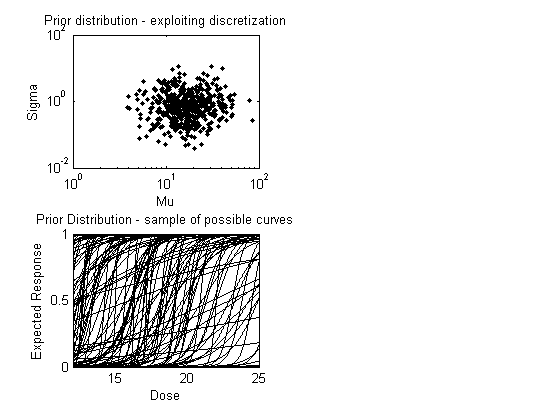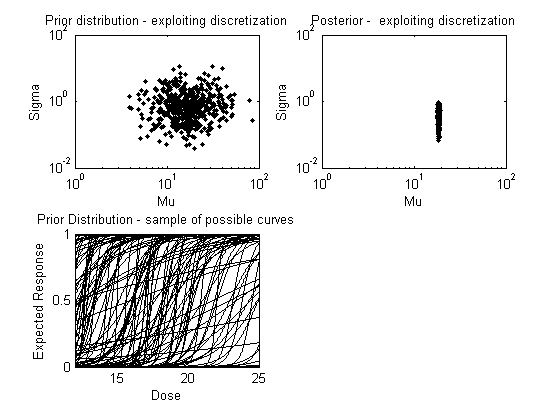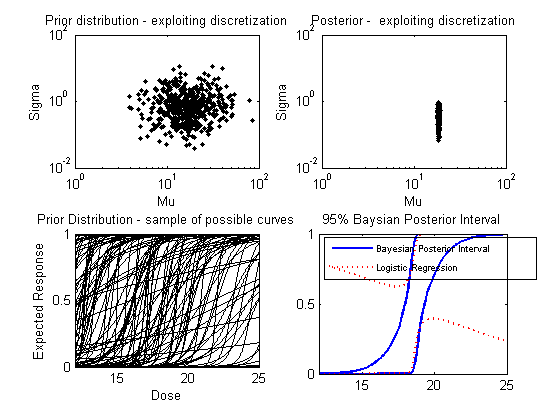Bayesian Posterior Interval allows interpretation of data. We suggst a method which allows estimation of posterior information even when the closed form of the posterior is very complex, exploiting a discretization of the prior distribution.
This need for posterior distribution is quite frequent, and we use it for the purpose of analyzing small sample data with generalized linear models. Using regression techniques for GLM with small samples is not reliable, and often highly biased.
The sequential experimental design examples already contain this utilization; here this idea is given a seperate example, for ready-made data.
This file contains a binomial example. X0 contains the location of the experiment, RResult contains the responses observed (0/1).
We provide 4 plots: (1) A presentation of the prior, by a sample of possible discrete points; (2) A presentation of the posterior, by discrete points; (3) A presentation of the prior by a sample of possible curves; (4) A presentation of the posterior interval vs. logistic regression confidence interval.
This script was written by Hovav Dror, Tel-Aviv University, 2006
If you make changes to the script, or if you implement it to a (to be) published problem, please inform us: dms@post.tau.ac.il ; hovavdror@gmail.com
further details, including papers describing the algorithm, can be found at: http://www.math.tau.ac.il/~dms/GLM_Design
NN=10000; % Number of parameter vectors to represent the prior using a discretization % If not much is known, you can use a very rough prior, for example: MedianMean=17; MuS=lognrnd(log(MedianMean),0.5,NN,1); MedianSigma=0.7; SigmaS=lognrnd(log(MedianSigma),1,NN,1); beta=[-MuS./SigmaS 1./SigmaS]; family='binomial'; link='logit'; model='linear';
Locations
X0=[ 17.0000
22.5000
19.4000
19.1000
16.4000
17.9000
18.4500
17.2000
18.8000
19.8000
18.5500
19.7500
18.7000
17.6200
19.4000
17.8400
18.0000
19.1500
18.1100
];
F0=x2fx(X0);
% Results:
RResult=[ 0
1
1
1
0
0
1
0
0
1
0
1
1
0
1
0
0
1
0
];
subplot(2,2,1); loglog(MuS(1:500),SigmaS(1:500),'k.');% A sample of 500 points from the prior, log-scale xlabel('Mu'); ylabel('Sigma'); title('Prior distribution - exploiting discretization'); x1=get(gca,'XLim'); y1=get(gca,'YLim'); subplot(2,2,3); xrange0=[12 25]; plot([xrange0(1) xrange0(1) xrange0(2)],[0 0 1],'w'); % empty figure hold on P=[]; for ii=1:150 % Plot a sampe of 150 possible curves, from the prior j=0; xrange=min([min(X0) xrange0(1)]):.01:max([max(X0) xrange0(2)]); % range for plotting figures for x=xrange j=j+1; P(j)=1 / (1 + exp(-beta(ii,1)-beta(ii,2)*x) ); end; plot(xrange,P,'k'); end; %for hold off set(gca,'XLim',xrange0); xlabel('Dose'); ylabel('Expected Response'); title('Prior Distribution - sample of possible curves');

RResultM=ones(NN,1)*RResult'; ex=exp(-F0*beta'); bprob=(1 ./ (1+ex))'; mprob=1-bprob; LRi = prod( bprob.^RResultM ,2 ) .* prod( mprob.^(1-RResultM) ,2); Weights=LRi/sum(LRi);
WMuSig=sortrows([Weights MuS SigmaS]); SW=cumsum(WMuSig(:,1)); MuSig1=WMuSig(SW>0.05,2:end); % Posterior possible beta values, for a 95% level Weights1=WMuSig(SW>0.05,1); Sample1=randsample(length(Weights1),500,true,Weights1); % Choose a Weighted sample of size 500 subplot(2,2,2); loglog(MuSig1(Sample1,1),MuSig1(Sample1,2),'k.');% A sample of 500 points from the posterior, log-scale xlabel('Mu'); ylabel('Sigma'); set(gca,'XLim',x1); set(gca,'YLim',y1); title('Posterior - exploiting discretization');

xrange=min([min(X0) xrange0(1)]):.1:max([max(X0) xrange0(2)]); % range for plotting figures Wbeta=sortrows([Weights beta]); SW=cumsum(Wbeta(:,1)); beta1=Wbeta(SW>0.05,2:end); P=[]; LL=ones(size(xrange)); UL=zeros(size(xrange)); i=0; for x=xrange i=i+1; for j=1:length(beta1) P=1 / (1 + exp(-beta1(j,1)-beta1(j,2)*x) ); if P<LL(i), LL(i)=P; end; if P>UL(i), UL(i)=P; end; end; end; subplot(2,2,4); h1=plot(xrange,LL,'LineWidth',2); hold on plot(xrange,UL,'LineWidth',2); hold off; title('95% Baysian Posterior Interval'); % And add a comparison to logistic regression (dotted red lines); [b,dev,stats] = glmfit(X0,[RResult ones(size(RResult))],'binomial'); [yfit,dlo,dhi] = glmval(b,xrange','logit',stats,0.95); hold on h2=plot(xrange,yfit-dlo,'r:','LineWidth',2); plot(xrange,yfit+dhi,'r:','LineWidth',2); hold off set(gca,'XLim',xrange0); h_legend=legend([h1 h2],'Bayesian Posterior Interval','Logistic Regression'); h_text = findobj(h_legend,'type','text'); set(h_text,'FontUnits','points','FontSize',7) set(h_text,'FontUnits','normal') set(h_legend,'Location','NorthWest'); set(h_legend, 'Color', 'none')
